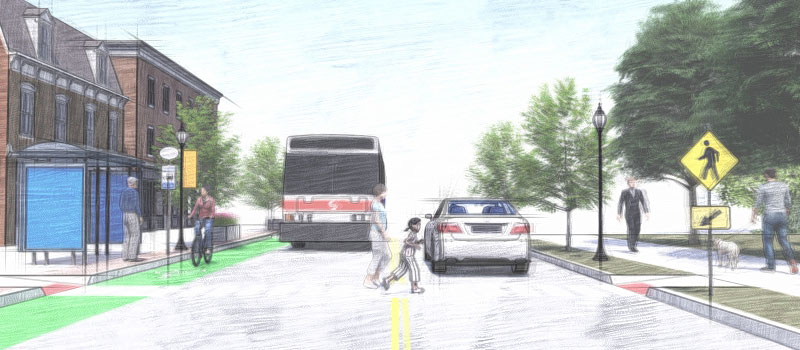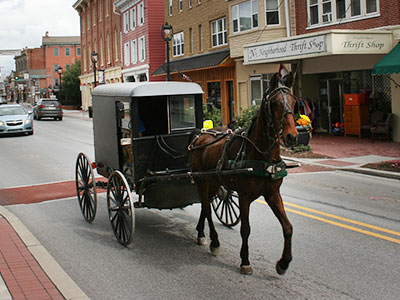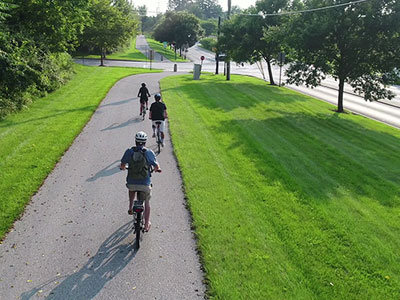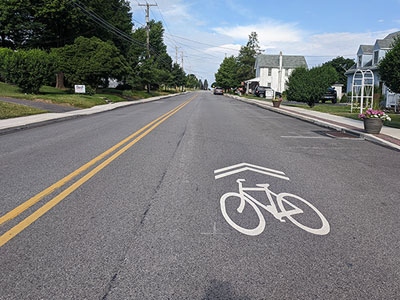Streets not designed to accommodate bicyclists or pedestrians can be very challenging for them.
Complete streets accommodate all modes, which includes horses and buggies in western Chester County.
Public transportation is a key component of a complete street.
How it Works
"Complete streets" represent an inclusive method of thinking about how roadway corridors are utilized.
By law, most roadways are accessible by many travel modes including but not limited to automobiles, trucks, pedestrians, and bicycles. In reality, roadways have become auto-centric, often unofficially excluding or deterring other modes of transportation. A complete streets policy is geared towards challenging the status quo while reevaluating new and existing roadways in order to transform the transportation network into a more efficient and equitable system for all modes of transportation.
Municipalities should consider the creation and adoption of a complete streets policy as the first step in reevaluating transportation networks with the understanding that some roadways are perfect, as is, for various modes of transportation, while others should be considered for updates. The process for considering whether a roadway is "complete" or needs reevaluation includes measuring safety, health, environmental, and economic components. In Chester County, publicly accessible roadways are owned by either PennDOT or the local municipality, and each municipality should consider creating and adopting a complete streets policy and/or endorsing the Chester County Complete Streets Policy.
Benefits
Safety
Streets designed for multiple modes of transportation may reduce pedestrian or bicyclist related accidents.
Health
Complete streets can create healthier lifestyles by creating networks that promote rather than deter active transportation. When people walk or ride a bike, they get more exercise.
Environment
Creating more convenient and accessible transportation opportunities enables commuters to choose lower emission options like walking, biking, or taking public transportation.
Economic
Complete streets can boost employment levels, increase property values, promote private sector investment, and provide new business opportunities, according to Safer Streets, Stronger Economies, a study by Smart Growth America.
Equity
Complete streets provide an equitable transportation network for all users regardless of transportation mode. This is particularly important for those who cannot drive because of income or physical limitations.
Sidewalks should be provided along streets in developed areas.
Trails next to streets are often the safest way to accommodate bicyclists of all skill levels.
At times, roads are not wide enough to easily accommodate all users, such as with bike lanes. In this case, a sharrow is used to alert drivers that bicycles will also be using the road.
Get Started
Municipalities should begin by establishing a compelling case in their various planning documents, especially the comprehensive plan, for the need for a complete streets policy. This can be done through an analysis of existing street conditions, traffic accidents, land uses, and community demographics. With this planning foundation established, the community should then create a strong vision for complete streets that helps focus overall policy and inspire community follow through.
As part of this vision, the community should create a core commitment to provide transportation opportunities for all users. Without a doubt, a strong complete streets policy emphasizes a clear intent to meet the needs of all users. Put in its simplest form, the core commitment states an intent to provide safe travel for everyone.
The complete streets policy should include a vision statement, general guidance for implementation, and applicability to different parts of a community. Municipalities may want to use the Chester County Complete Streets Policy as a guide.
Once a policy is developed, complete streets concepts should be folded into many different aspects of a municipality's operations. Municipalities may want to set goals for next steps of implementation, which might include designing for new construction, reconstruction, rehabilitation, repair, maintenance, or operations work. When PennDOT is repaving a road, or the municipality is repaving one of its roads, complete streets can be part of the restriping, with crosswalks and bike lanes added to the street.
Zoning and subdivision and land development ordinances should be changed to specifically include requirements for complete streets elements, such as sidewalks, crosswalks, bike lanes, and bus shelters. When planning commissions and elected officials review land development proposals, they can negotiate with a developer on incorporating complete streets elements.
Finally, there are many grants available for complete streets implementation, and municipalities should look to retrofit their existing streets to make them more compatible for pedestrians, bicyclists, and transit users by adding sidewalks, cross walks, bike lanes, traffic calming, and bus shelters.
Considerations
Applicability
Generally, complete streets policies are applicable to all highways and roads in Chester County, although they are not appropriate for the cartways of limited access highways like the PA Turnpike or the Route 1 expressway. In addition, not every community or every part of a single municipality is the same. Because of this, municipalities may need to vary their complete street expectations depending on the location, particularly in relation to rural, suburban, and urban areas.
Exceptions
Although complete streets are encouraged along all streets, there may be exceptions that municipalities should consider. These may be due to maintenance needs, excessive costs for implementing complete streets, limited impact, the legal prohibition of pedestrians or bicyclists, or other reasons to have an exception from the norm. Any potential exceptions should be carefully reviewed and approved, with public notice identifying the list of exceptions being considered and their justification.
Examples

Chester County
The Chester County Complete Streets Policy provides a framework for a local complete streets policy.

Pennsylvania
Pennsylvania's WalkWorks program prepared a Complete Streets Policies in Pennsylvania Case Study and provides support for walking and complete streets.

Anne Arundel County, Maryland
Complete Streets Policies and Strategies offer a way to effectively focus investments in transportation infrastructure. The county advocated for complete streets for many years.








